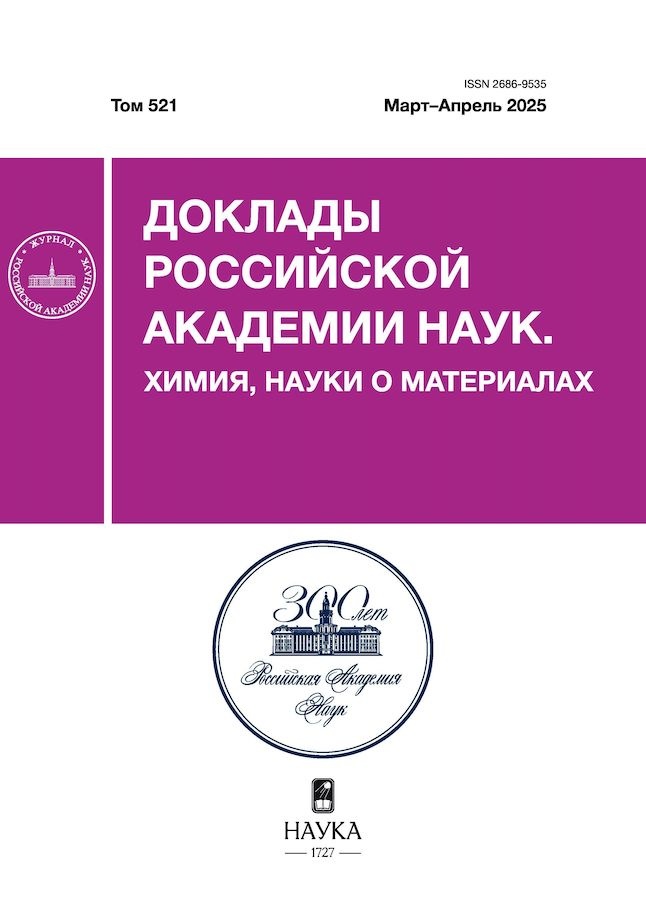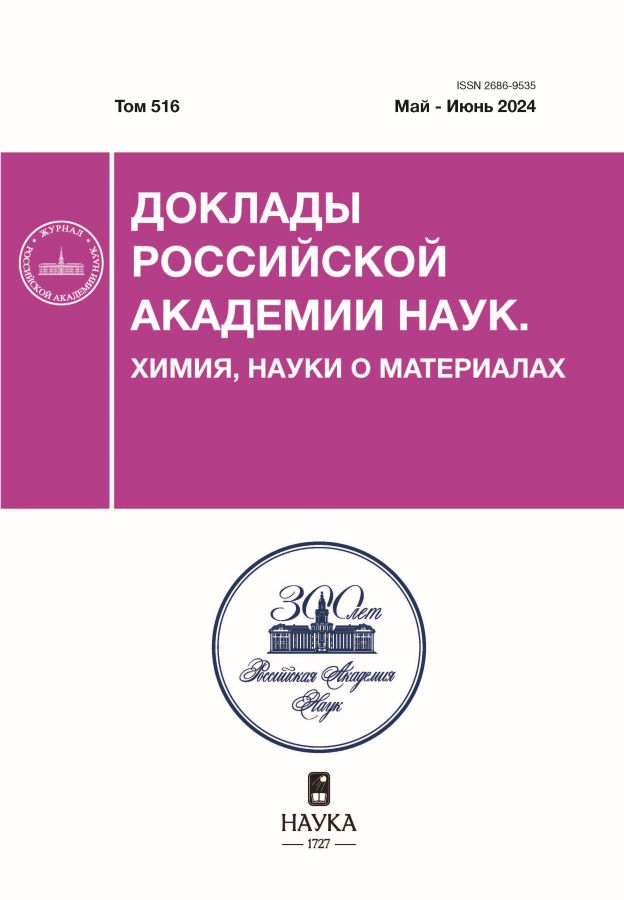Структура гуматов в водных растворах и их биологическая активность
- Авторы: Федотов Г.Н.1, Шоба С.А.1, Горепекин И.В.1, Грачева Т.А.1, Качалкин А.В.1,2, Конкина У.А.1, Ушкова Д.А.1
-
Учреждения:
- Факультет почвоведения МГУ имени М.В.Ломоносова
- Институт биохимии и физиологии микроорганизмов им. Г.К. Скрябина Федерального исследовательского центра “Пущинский научный центр биологических исследований Российской академии наук”
- Выпуск: Том 516, № 1 (2024)
- Страницы: 39-44
- Раздел: ФИЗИЧЕСКАЯ ХИМИЯ
- URL: https://ter-arkhiv.ru/2686-9535/article/view/651907
- DOI: https://doi.org/10.31857/S2686953524030057
- EDN: https://elibrary.ru/ZIGNPT
- ID: 651907
Цитировать
Полный текст
Аннотация
Известно, что гуминовые вещества (ГВ) формируют из частиц-молекул (первичных частиц ГВ) надмолекулярные образования (НМО). Позже было показано, что существует барьерная концентрация ГВ, ниже которой в растворе гуминовых веществ последние находятся только в виде частиц-молекул, а при концентрации, превышающей барьерную – только в виде НМО. Из этого следует, что свойства растворов ГВ должны определяться тем, в каком виде (частиц-молекул или НМО) находятся в растворах ГВ. Целью исследования была проверка влияния формы существования ГВ в растворах на свойства этих растворов и их биологическую активность. В работе использовали растворы гумата калия из бурого угля. Результаты экспериментов показали, что при увеличении концентрации гуматов рН скачкообразно увеличивается в диапазоне 30−50 мг л⁻¹. Установлено, что при культивировании некоторых видов микроорганизмов в питательных средах, приготовленных на растворах гуматов, микроорганизмы развивались намного активнее при нахождении в питательных средах ГВ в виде частиц-молекул. Также показано, что при фолиарной обработке побегов огурца растворами гуматов с концентрацией ниже барьерной эффект стимуляции возрастал. По-видимому, увеличение стимуляции связано с тем, что частицы-молекулы из-за малого размера могли поглощаться клетками растений.
Полный текст
Об авторах
Г. Н. Федотов
Факультет почвоведения МГУ имени М.В.Ломоносова
Автор, ответственный за переписку.
Email: gennadiy.fedotov@gmail.com
Россия, 119992 Москва
С. А. Шоба
Факультет почвоведения МГУ имени М.В.Ломоносова
Email: gennadiy.fedotov@gmail.com
член-корреспондент РАН
Россия, 119992 МоскваИ. В. Горепекин
Факультет почвоведения МГУ имени М.В.Ломоносова
Email: gennadiy.fedotov@gmail.com
Россия, 119992 Москва
Т. А. Грачева
Факультет почвоведения МГУ имени М.В.Ломоносова
Email: gennadiy.fedotov@gmail.com
Россия, 119992 Москва
А. В. Качалкин
Факультет почвоведения МГУ имени М.В.Ломоносова; Институт биохимии и физиологии микроорганизмов им. Г.К. Скрябина Федерального исследовательского центра “Пущинский научный центр биологических исследований Российской академии наук”
Email: gennadiy.fedotov@gmail.com
Россия, 119992 Москва; 142290 Пущино
У. А. Конкина
Факультет почвоведения МГУ имени М.В.Ломоносова
Email: gennadiy.fedotov@gmail.com
Россия, 119992 Москва
Д. А. Ушкова
Факультет почвоведения МГУ имени М.В.Ломоносова
Email: gennadiy.fedotov@gmail.com
Россия, 119992 Москва
Список литературы
- Орлов Д.С. Гумусовые кислоты почв и общая теория гумификации. М.: Изд-во МГУ, 1990. с. 325.
- Österberg R., Mortensen K. // Eur. Biophys. J. 1992. V. 21. № 3. P. 163–167. https://doi.org/10.1007/BF00196759
- Angelico R., Colombo C., Di Iorio E., Brtnický M., Fojt J., Conte P. // Appl. Sci. 2023. V. 13. № 4. 2236. https://doi.org/10.3390/app13042236
- Senesi N., Wilkinson K.J. Biophysical chemistry of fractal structures and processes in environmental systems. Senesi N., Wilkinson K.J. (Eds.). John Wiley & Sons Ltd., 2008. p. 342.
- Федотов Г.Н., Шеин Е.В., Ушкова Д.А., Салимгареева О.А., Горепекин И.В., Потапов Д.И. // Почвоведение. 2023. № 8. С. 903–908. https://doi.org/10.31857/S0032180X22601608
- Милановский Е.Ю. Гумусовые вещества почв как природные гидрофобно-гидрофильные соединения. М.: ГЕОС. 2009. с. 186.
- Nardi S., Pizzeghello D., Muscolo A., Vianello A. // Soil Biol. Biochem. 2002. V. 34. №. 11. P. 1527–1536. https://doi.org/10.1016/S0038-0717(02)00174-8
- Asli S., Neumann P.M. // Plant Soil. 2010. V. 336. P. 313–322. https://doi.org/10.1007/s11104-010-0483-2
- Scherrer R., Louden L., Gerhardt P. // J. Bacteriol. 1974. V. 118. № 2. P. 534–540. https://doi.org/10.1128/jb.118.2.534-540.1974
- De Nobel J.G., Barnett J.A. // Yeast. 1991. V. 7. № 4. P. 313–323. https://doi.org/10.1002/yea.320070402
- Visser S.A. // Soil Biol. Biochem. 1985. V. 17. № 4. P. 457–462. https://doi.org/10.1016/0038-0717(85)90009-4
- Fasurová N., Čechlovská H., Kučerik J. // Pet. Coal. 2006. V. 48. № 2. P. 24–32.
- Евдокимов И.П., Лосев А.П. Природные нанообъекты в нефтегазовых средах. М.: РГУ нефти и газа им. И.М. Губкина, 2008. с. 104.
- Arachchige M.S.A., Mizutani O., Toyama H. // Biotechnol. Biotechnol. Equip. 2019. V. 33. № 1. P. 1505–1515. https://doi.org/10.1080/13102818.2019.1676167
- Spaccini R., Piccolo A., Conte P., Haberhauer G., Gerzabek M.H. // Soil Biol. Biochem. 2002. V. 34. № 12. P. 1839–1851. https://doi.org/10.1016/S0038-0717(02)00197-9
- Воюцкий С.С. Курс коллоидной химии. М.: Химия, 1975. с. 512.
- Sampaio J.P. // Can. J. Microbiol. 1999. V. 45. № 6. P. 491–512. https://doi.org/10.1139/w99-020
- Tikhonov V.V., Yakushev A.V., Zavgorodnyaya Y.A., Byzov B.A., Demin V.V. // Eurasian Soil Sci. 2010. V. 43. P. 305–313. https://doi.org/10.1134/S1064229310030087
Дополнительные файлы















